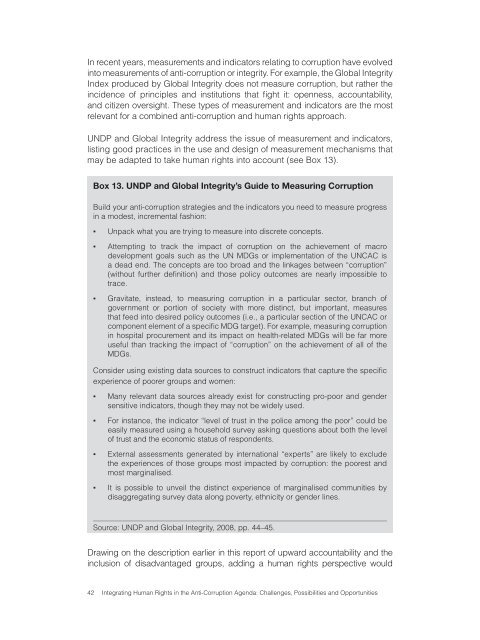Integrating Human Rights in the Anti-Corruption Agenda - The ICHRP
Integrating Human Rights in the Anti-Corruption Agenda - The ICHRP
Integrating Human Rights in the Anti-Corruption Agenda - The ICHRP
You also want an ePaper? Increase the reach of your titles
YUMPU automatically turns print PDFs into web optimized ePapers that Google loves.
In recent years, measurements and <strong>in</strong>dicators relat<strong>in</strong>g to corruption have evolved<br />
<strong>in</strong>to measurements of anti-corruption or <strong>in</strong>tegrity. For example, <strong>the</strong> Global Integrity<br />
Index produced by Global Integrity does not measure corruption, but ra<strong>the</strong>r <strong>the</strong><br />
<strong>in</strong>cidence of pr<strong>in</strong>ciples and <strong>in</strong>stitutions that fight it: openness, accountability,<br />
and citizen oversight. <strong>The</strong>se types of measurement and <strong>in</strong>dicators are <strong>the</strong> most<br />
relevant for a comb<strong>in</strong>ed anti-corruption and human rights approach.<br />
UNDP and Global Integrity address <strong>the</strong> issue of measurement and <strong>in</strong>dicators,<br />
list<strong>in</strong>g good practices <strong>in</strong> <strong>the</strong> use and design of measurement mechanisms that<br />
may be adapted to take human rights <strong>in</strong>to account (see Box 13).<br />
Box 13. UNDP and Global Integrity’s Guide to Measur<strong>in</strong>g <strong>Corruption</strong><br />
Build your anti-corruption strategies and <strong>the</strong> <strong>in</strong>dicators you need to measure progress<br />
<strong>in</strong> a modest, <strong>in</strong>cremental fashion:<br />
▪<br />
▪<br />
▪<br />
Unpack what you are try<strong>in</strong>g to measure <strong>in</strong>to discrete concepts.<br />
Attempt<strong>in</strong>g to track <strong>the</strong> impact of corruption on <strong>the</strong> achievement of macro<br />
development goals such as <strong>the</strong> UN MDGs or implementation of <strong>the</strong> UNCAC is<br />
a dead end. <strong>The</strong> concepts are too broad and <strong>the</strong> l<strong>in</strong>kages between “corruption”<br />
(without fur<strong>the</strong>r def<strong>in</strong>ition) and those policy outcomes are nearly impossible to<br />
trace.<br />
Gravitate, <strong>in</strong>stead, to measur<strong>in</strong>g corruption <strong>in</strong> a particular sector, branch of<br />
government or portion of society with more dist<strong>in</strong>ct, but important, measures<br />
that feed <strong>in</strong>to desired policy outcomes (i.e., a particular section of <strong>the</strong> UNCAC or<br />
component element of a specific MDG target). For example, measur<strong>in</strong>g corruption<br />
<strong>in</strong> hospital procurement and its impact on health-related MDGs will be far more<br />
useful than track<strong>in</strong>g <strong>the</strong> impact of “corruption” on <strong>the</strong> achievement of all of <strong>the</strong><br />
MDGs.<br />
Consider us<strong>in</strong>g exist<strong>in</strong>g data sources to construct <strong>in</strong>dicators that capture <strong>the</strong> specific<br />
experience of poorer groups and women:<br />
▪<br />
▪<br />
▪<br />
▪<br />
Many relevant data sources already exist for construct<strong>in</strong>g pro-poor and gender<br />
sensitive <strong>in</strong>dicators, though <strong>the</strong>y may not be widely used.<br />
For <strong>in</strong>stance, <strong>the</strong> <strong>in</strong>dicator “level of trust <strong>in</strong> <strong>the</strong> police among <strong>the</strong> poor” could be<br />
easily measured us<strong>in</strong>g a household survey ask<strong>in</strong>g questions about both <strong>the</strong> level<br />
of trust and <strong>the</strong> economic status of respondents.<br />
External assessments generated by <strong>in</strong>ternational “experts” are likely to exclude<br />
<strong>the</strong> experiences of those groups most impacted by corruption: <strong>the</strong> poorest and<br />
most marg<strong>in</strong>alised.<br />
It is possible to unveil <strong>the</strong> dist<strong>in</strong>ct experience of marg<strong>in</strong>alised communities by<br />
disaggregat<strong>in</strong>g survey data along poverty, ethnicity or gender l<strong>in</strong>es.<br />
Source: UNDP and Global Integrity, 2008, pp. 44–45.<br />
Draw<strong>in</strong>g on <strong>the</strong> description earlier <strong>in</strong> this report of upward accountability and <strong>the</strong><br />
<strong>in</strong>clusion of disadvantaged groups, add<strong>in</strong>g a human rights perspective would<br />
42 <strong>Integrat<strong>in</strong>g</strong> <strong>Human</strong> <strong>Rights</strong> <strong>in</strong> <strong>the</strong> <strong>Anti</strong>-<strong>Corruption</strong> <strong>Agenda</strong>: Challenges, Possibilities and Opportunities

















